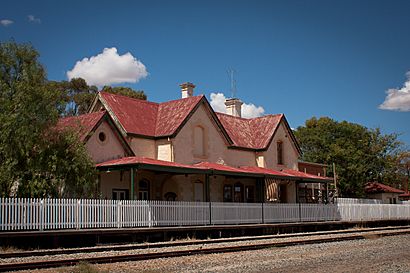York railway station, Western Australia facts for kids
Quick facts for kids
York
|
|
|---|---|

York railway station in 2011
|
|
| Location | Railway Street, York |
| Coordinates | 31°53′31″S 116°45′57″E / 31.891958°S 116.76582°E |
| Owned by | Westrail |
| Operated by | Westrail |
| Distance | 161 kilometres from Perth |
| Platforms | 1 |
| Tracks | 2 |
| Construction | |
| Structure type | Ground |
| History | |
| Opened | 29 June 1885 |
| Closed | 1 December 1978 |
| Type | State Registered Place |
| Designated | 7 December 2007 |
| Reference no. | 2899 |
York railway station is an old train station in York, a town in Western Australia. It was once part of the Eastern Railway line. The station opened in 1885 and served the community for many years before closing in 1978. Today, it is a heritage-listed site, meaning it's an important historical building.
Contents
History of York Station
When the Station Opened
The York station first opened its doors on 29 June 1885. At that time, it was the end of the Eastern Railway line, which had been extended from Chidlow's Well. This was a big deal for the town of York!
York as a Junction
York soon became a very important train hub, known as a junction station. On 5 August 1886, a new railway line opened, connecting York south to Beverley. This new line linked up with the Great Southern Railway, which ran all the way from Albany.
When the railway reached York, it was a moment of great celebration. People were excited about how the trains would help the town grow. The railway made it easier for people to travel and for goods to be moved.
Train Fares and Early Impact
Back then, a one-way ticket from Perth to York cost 5 shillings. A return ticket was 7 shillings and sixpence.
The arrival of the railway changed the area a lot. It helped the Avon Valley region become a major place for growing wheat. The railway also brought new people to York and the Avon Valley, including construction workers, railway employees, and settlers.
Later, between 1890 and 1894, many gold-seekers used the railway. They would travel by train from Albany and Fremantle to York. From York, they would get supplies and then head off to the Goldfields by cart or on foot. They followed tracks and wells that had been set up years before.
Later Railway Lines and Closure
Another railway line, the Bruce Rock line, opened east from York to Greenhills on 1 September 1898. This line was later extended to Quairading in 1908 and then to Bruce Rock in 1913. However, parts of this line were closed over time, and it shut down completely in October 2013.
Even though York was the biggest inland town in Western Australia at the time, the Eastern Railway was extended to Southern Cross in 1894 through Northam, not York.
The York station building itself was made bigger in 1906. In 1977, it was officially recognized as a heritage site by the National Trust of Australia. The last passenger train service to use the station was called the Albany Progress, which stopped running in December 1978.
Railway Station Master’s Quarters
Design of the Quarters
The house where the Railway Station Master lived was designed by George Temple-Poole. He was a very important architect and had just become the Principal Architect in June 1885. This house was one of his first projects in this new role.
Architectural Style
The building is thought to be one of the earliest examples of the Federation Arts and Crafts style in Australia. This style was inspired by English buildings, especially those found in places like Bibury in Gloucestershire, a charming village in the Cotswold region.
Temple-Poole designed the Station Master's Quarters to look like a cozy Cotswold cottage. Here are some of its features:
- It is small and has a homely, welcoming feel.
- It uses two local materials: stone and brick. These materials have different colors and textures.
- The roofs are tall and steeply sloped.
- The windows are placed in an uneven, interesting way.
- The chimneys are taller than usual.
- The roof edges (eaves) stick out a bit.
- It has two pointed sections on the roof called gables.
Today, this historic building is no longer part of the railway. It is now a private home.

